Whether you’re building a car emergency kit, bug out bag, or disaster supplies stockpile, you will need some way to stay warm. For many, this means getting an “emergency blanket.” Unfortunately, there is a lot of misinformation about how emergency blankets work and their capabilities.
Before you get a cheap Mylar blanket to put in your kit (or any other blanket marketed for survival), read this guide to learn what you really need to stay alive in cold temperatures.
The Quick Overview:
When you have the choice, a sleeping bag will almost always beat a blanket. But, for emergencies, a survival blanket can keep you alive and possibly comfortable.
Mylar space blankets don’t provide insulation; they only stop heat loss from evaporation and radiation. By contrast, wool and fleece blankets will insulate you.
The best solution?
Pack BOTH a Mylar blanket and a wool blanket. Wrap the wool blanket around you and the Mylar blanket around that. Or, use the wool blanket for its insulating warmth and use the Mylar blanket as a fire reflector.
Top Picks
A Sleeping Bag is Better than an Emergency Blanket!
A suitable sleeping bag will outperform an emergency blanket in almost every situation.
By “good” sleeping bag, I mean a mummy bag rated at least 32 degrees F (but preferably rated to whatever the winter low is in your region). As far as material goes, synthetic bags are great because they dry quickly. Down bags are much warmer and lighter but will get ruined if they get wet.
I simply cannot comprehend why someone would put a $3 “blanket” in their car trunk instead of a sleeping bag. Yes, good sleeping bags are expensive, but even a cheap one will do a better job saving your life than a $3 emergency blanket!
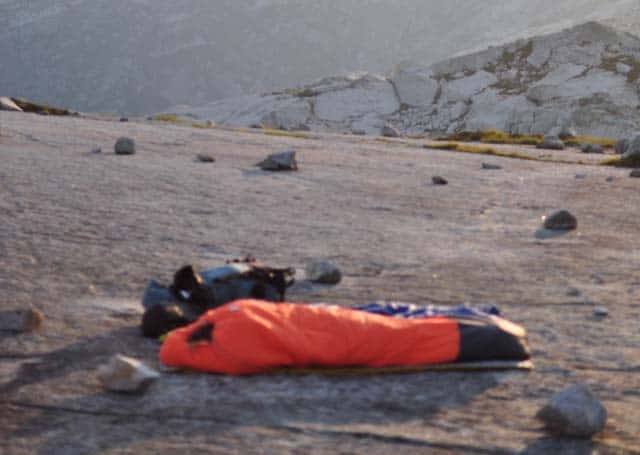
When Packing an Emergency Blanket Actually Makes Sense
No, you should NOT bring an emergency blanket camping, backpacking, or on overnight trips as your primary shelter. Emergency blankets are meant to be used in EMERGENCIES.
That means you should be carrying emergency blankets in situations like:
While hiking, in case you get lost/injured and need to survive the night until help can arrive.
In your first aid kit to be used for preventing shock.
After running a marathon.
In any compact emergency kits which won’t fit a sleeping bag.
If you really can’t afford a sleeping bag since a cheap emergency blanket is better than nothing.
For example, my hiking packing list contains a Mylar blanket. If something happened, I could make a shelter or wear it as a poncho.
People like to think that they are invincible and sh*t won’t happen to them – but there are countless examples from the news where even experienced hikers get into trouble.
I don’t count on the Mylar blanket to keep me comfortable (that’s what I’ve got a sleeping bag waiting for me at camp for!). But the Mylar blanket (and my outdoor skills) will keep me alive.
Bottom line?
Get BOTH a sleeping bag and an emergency blanket. Keep both in your emergency kits (home, car, BOB). The sleeping bag will keep you warm and comfy. The emergency blanket is a backup and can be used in ways that a sleeping bag can’t – such as insulating your tent or car.
Types of Emergency Blankets
When talking about emergency blankets, it is usually those cheap Mylar bags that come to mind (aka “space blankets”). But other types of blankets can be used in emergencies.
These emergency blankets work differently, so you must understand them before throwing one in your kit.
How We Lose Body Heat
I know you probably didn’t expect a science lesson now, but understanding heat loss is essential if you want to know the “best” survival blanket. Some blankets only prevent 1 or 2 types of heat loss.
The 4 Basic Types of Heat Loss
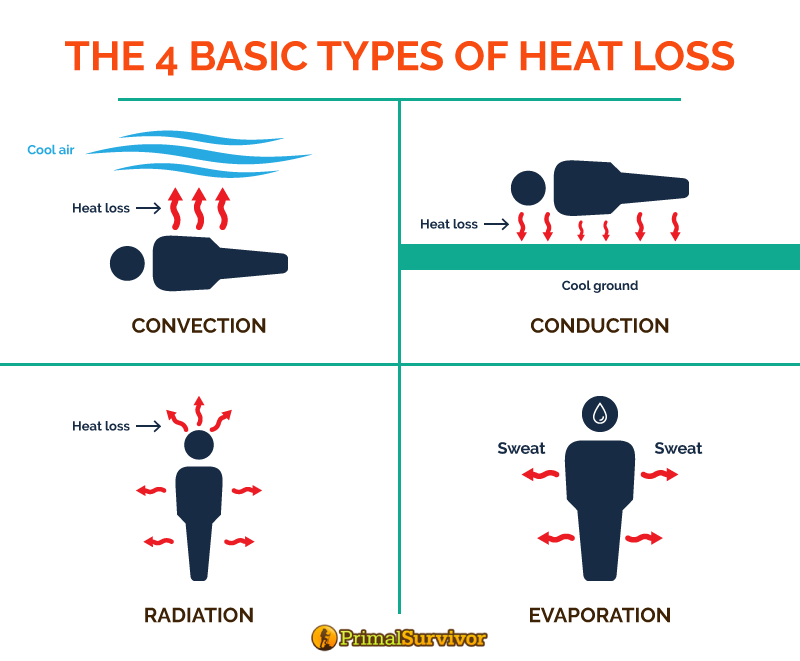
- Convection: This occurs when warmer air moves towards cooler air. Insulation – such as jackets or wool blankets – will reduce heat loss from convection. Any windproof barrier (such as a Mylar blanket) will also prevent this type of heat loss since wind causes convection heat loss.
- Conduction: Occurs when heat goes from warmer to cooler surfaces through a solid object. For example, if you don’t have an insulating layer below you (such as a sleeping pad or pile of pine needles), the ground will suck heat out of you through conduction.
- Radiation: This is the process of heat moving away from its source, like heat radiating off of a wood stove. The body loses 65% of its heat through radiation in temperatures 65F and below. Reflective materials can prevent radiation heat loss.
- Evaporation: This is heat loss from moisture (sweat) evaporating. Evaporation is why it is so important to stay dry while outdoors. Waterproof materials can prevent evaporative heat loss.
For example, comparing a wool and a Mylar blanket is pointless since they do different things.
A Mylar blanket will prevent heat loss from evaporation and radiation, whereas the wool blanket mainly prevents heat loss from convection. That’s why you need BOTH types to stay warm in really cold weather.
Overview of Emergency Blanket Types
Mylar Blankets
Take up little space
Reflect heat
Multiple uses
Waterproof
Block wind
Tear easily
Don’t provide any insulation
Must know how to properly use
Wool Blankets
Repels water
Trap heat well
Cheap
Block some wind
Durable
Insulate even when wet
Itchy
Bulky and heavy
Take long time to dry once saturated
Fleece Blankets
Soft
Compact
Dry quickly
Easy to wash
Don’t insulate when wet
Melt/catch fire easily
Don’t block much wind
Absorb water
1. Mylar Blankets
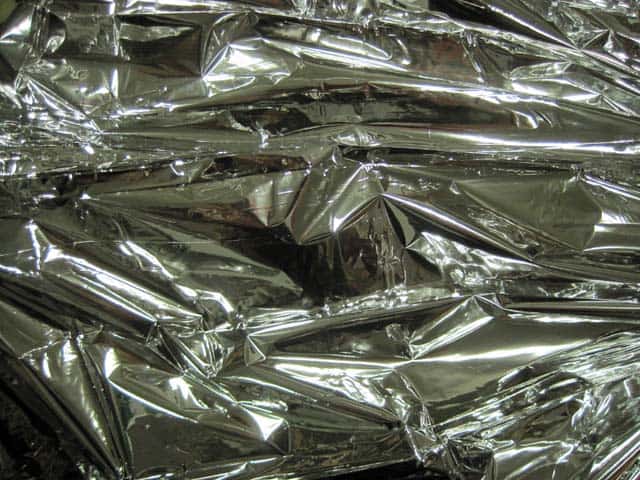
Mylar blankets are also called space, solar, or survival blankets. NASA is behind the original technology of Mylar blankets (and manufacturers are quick to hype this fact).
Mylar blankets aren’t blankets in the usual sense. Instead, they are made of vaporized aluminum layered on a thin plastic sheet. The aluminum is reflective and prevents heat loss from radiation.
They are often given out to runners at the end of marathons. Why? Because body heat drops quickly after you stop running, and the Mylar helps reflect the runner’s heat back to them.
Important Note: Mylar blankets are often hyped up by manufacturers. You can’t just wrap a Mylar blanket around you and expect to stay warm! Whether or not a Mylar blanket will work for survival depends on how you use it.
Please read our post which covers how to use a Mylar blanket before you pack one in your emergency kit.
Characteristics of Mylar Blankets
Mylar blankets are different than regular blankets. You can’t use them like a standard blanket and expect to stay warm! However, if you know the characteristics of Mylar, you can use them to your advantage in a survival situation.
These characteristics are especially useful if you combine Mylar with an insulator (such as a wool blanket, a bed made of dry leaves, etc.).
Reflective:
The aluminum is reflective, which allows the blanket to reflect heat. This feature means you can reflect your body heat back towards you (to stay warm). Or you can reflect heat away from you (such as by putting it on top of your survival tent to keep it cooler).
A good Mylar blanket will reflect around 80% of heat back towards you. While that sounds impressive, it only accounts for 80% of radiating heat. Only about 50% of our heat loss is from radiation – and much of that is going out from our heads. So, a Mylar blanket by itself won’t keep you very warm. You’ll still want an insulating layer.
Another way to use Mylar’s reflective properties is to signal for help. You can even find some Mylar blankets with SOS stamped on them.
Waterproof:
Mylar blankets are also waterproof, so they will stop evaporation. That means Mylar blankets prevent heat loss from evaporation. It also means you can use a Mylar blanket to make a survival shelter. They work great for making lean-to-type shelters. You can also line your shelter with a Mylar blanket to help trap heat inside.
Windproof:
Mylar blankets will block wind, which makes them great for lining the inside of shelters. You can also wrap them around you on a windy day to block the wind. This way, you’ll be able to prevent some heat loss from convection.
You’ll probably want some paracord or duct tape to hold the Mylar blanket around you because they flutter like crazy in the wind!
Durable:
Considering how thin Mylar blankets are, they are very durable. Unfortunately, they get very weak once punctured. When a pine needle (or similar) pokes through the Mylar, it will rip along the puncture point. It’s a good idea to have duct tape in your survival kit to repair any tears to Mylar (I wrap duct tape around a lighter).
Cheap:
Usually, I wouldn’t list “cheap” as a positive characteristic of something. However, in the case of Mylar, you’ll appreciate that they are cheap. You can buy entire packs of cheap Mylar blankets to put in your car trunk or home emergency supplies. Then, if needed, you can use a bunch of them for various tasks like collecting water, lining a shelter, or making a poncho.
If you are only going to carry one or two Mylar blankets with you (such as in a BOB), then make sure you are getting a better-quality one. Pay the extra few dollars for a thicker Mylar blanket that resists puncture better.
 Arcturus Heavy Duty Mylar Blanket
Arcturus Heavy Duty Mylar Blanket
2. Wool Blankets
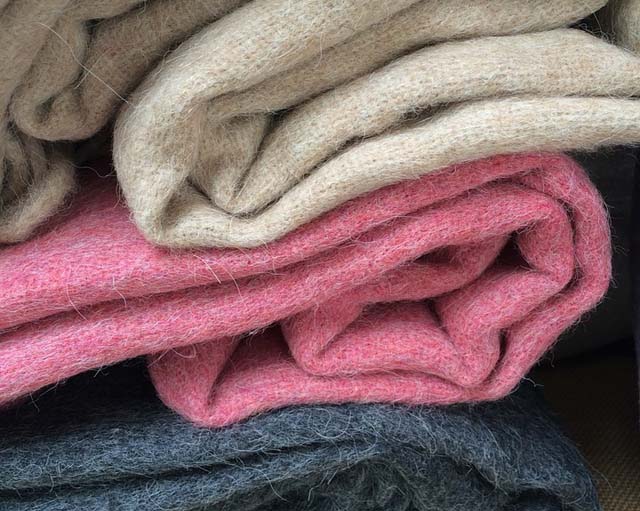
There is a lot of debate about whether a wool blanket or sleeping bag is better. I prefer a sleeping bag. They are more comfortable, and the shape traps heat better.
However, for emergencies, wool blankets do have their benefits. Particularly, wool blankets are more versatile than sleeping bags.
You can:
Cut a hole in the wool blanket to wear as a poncho
Wrap it around you for warmth while you walk (though you could also do this with a sleeping bag)
Use it in the rain and still get some warmth
Fold it and use as a ground sheet
Hang it in your car/shelter as insulation
Characteristics of Wool Blankets
Wool is a truly amazing material. It not only traps heat well (insulator) but can help you survive in many other ways.
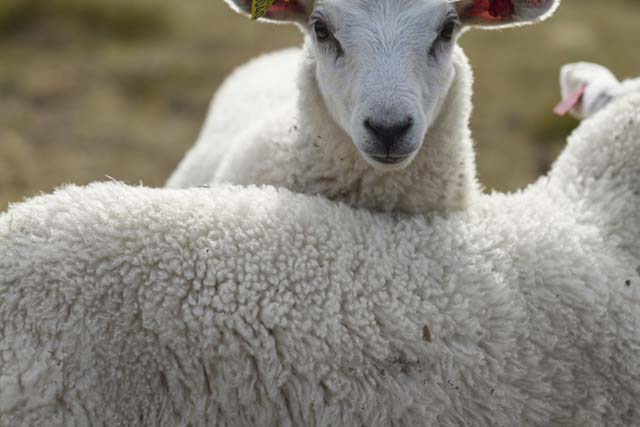
Naturally repels water:
In light rains, wool is great. It will naturally repel water to help keep you dry. However, wool isn’t so great in heavy rains. Once it is saturated, it will take FOREVER to dry!
Works when wet:
One of the hyped properties of wool is that it insulates while wet. While this is true, studies (like this one) show that the insulating factor is misleading.
A wet wool blanket will not provide nearly as much insulation as a dry blanket. That’s because the water in the wool will suck heat out of you. It just won’t suck nearly as much heat out of you as a wet cotton blanket. Why? Because there are still lots of air pockets in a wet wool blanket compared to a wet cotton blanket.
A soaking wet wool blanket will provide the same insulation as air. What does this mean for survival situations?
- If it is raining, you are better off with a wet wool blanket around you than no protection.
- If it is not raining, don’t put a wet wool blanket over you. The dry air will keep you warmer than a wet blanket! The exception is if it is very windy or cold out.
Durable:
Wool blankets can take a beating! You can put them over brush shelters or pine beds without worrying about punctures/rips. Wool is also naturally flame retardant, so if a few stray sparks from your fire get on it, it won’t be ruined.
Blocks some wind:
It won’t block as much wind as a Mylar blanket, but wool will provide some protection against wind. This will help slow down the heat loss from convection.
Recommended Wool Blanket
One great thing about wool blankets is that you can buy them cheaply. You can often find them in Army surplus stores for next-to-nothing. Just be warned that those cheap wool blankets often are “repurposed” and contain a high percentage of synthetics. You want a wool blanket as close to 100% wool as possible.
Also, be warned that those cheap wool blankets are itchy as hell. Softer wool (such as Merino wool) can cost a small fortune.
3. Polar Fleece
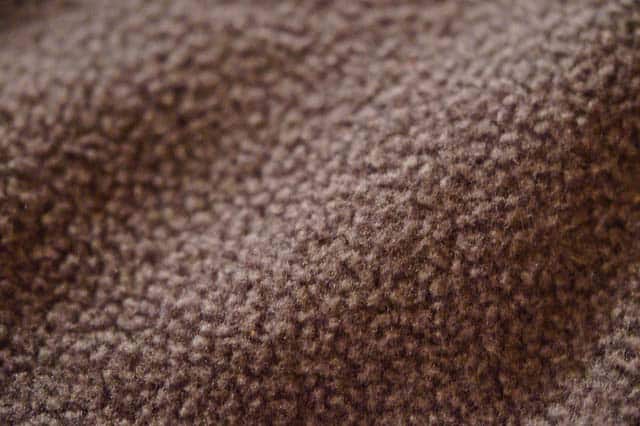
Just like wool, polar fleece works by providing insulation. However, fleece and wool are really different materials. I prefer fleece for indoor use (such as inside a car or “hunker-down” emergency kit). Wool works better in outdoor situations.
Characteristics of Fleece Blankets
- Soft and comfy: Compared to wool, fleece is really soft. It won’t irritate your skin like wool will. If you have small children, fleece is probably the better option for a survival blanket. Recommended: Prepping With Children
- Lightweight and compact: Fleece is lightweight and can be folded down very compact. This is not true of wool!
- Absorbs water: Fleece acts like a sponge in water. Even in light rain, it will quickly get soaked!
- Dries quickly: Yes, fleece absorbs water like a sponge – but it also dries fast (at least compared to wool).
- Gets damaged easily: Fleece punctures very easily. It also MELTS. This is important, especially if you use it around a fire. Even a tiny spark from the fire will make a hole in fleece.
- Not windproof: The fluffiness of fleece means it won’t block much wind. You’ll need a shell around them to stay warm. That’s why hikers/backpackers use fleece jackets under a hard-shell jacket.
 Extreme Weather Outdoor Blanket by Mambe
Extreme Weather Outdoor Blanket by Mambe
Other Options
Mylar, wool, and fleece are the most common survival blanket options. However, you might also consider these:
- Down: Down is fantastic as a survival blanket. It has a high R-factor for its weight. They compress well but shouldn’t be stored in their stuff sacks. It won’t work if the down gets compressed too much. You’ve got to keep them fluffed — which means they aren’t suitable for BOBs that need to be grabbed in a hurry. Down blankets are also pretty expensive. 🙁
- Poncho Liner/Woobie: People who served in the military will swear by their woobie. A woobie has many of the same characteristics as a Mylar blanket but is more durable.
- Synthetics: There are now lots of synthetic materials which mimic the properties of wool or fleece. Most are made of polyester, so are waterproof and durable. The quality of these blankets varies drastically.
The Best Emergency Blankets Reviewed
Go Time Survival Blanket
As far as Mylar space blankets go, the Go Time brand has a decent reputation.
These come in a 4 pack but are reusable (though you’ll have a hard time folding it back down). Note that these are VERY thin. This means that they are lightweight but will tear pretty easily.
Features:
- Double-sided
- Waterproof and windproof
- Silver on both sides
- Reflective – can be used for emergency signalling
- 12 microns thick – tears easily!
- 3oz weight (each)
Arcturus Heavy Duty Blanket
These space blankets also get really good reviews. They are less likely to tear than some other cheap brands.
They have a 3-layer construction which helps prevent rips (which is why they weigh more). They are a bit more expensive than other space blankets but are much more durable.
Features:
- Multiple color options
- Made in USA
- 1 blanket per pack
- 22oz
- 3-layer construction
- Resists tearing well
Go Time Emergency Bivvy
Go Time is another brand that always gets mentioned for best survival blanket. They make many emergency blankets, but their bivvy is my personal favorite. I like that it has a stuff sack, so you don’t have to worry about folding it to reuse.
The survival bivvy is only 4.1oz. Just like other lightweight survival blankets, you’ll need to be careful that it doesn’t rip or tear.
Features:
- Mylar
- Bivvy shape
- Waterproof and windproof (including seams)
- 4.1oz
- 84×36″
- Packs down to fit in a pocket
- Stuff sack
Best Fleece Blanket: Mambe Extreme Waterproof Fleece Blanket
In pretty much every forum and review, this always gets mentioned as the best survival blanket. It has a soft fleece interior which is excellent for providing insulation.
The exterior is nylon, so it is waterproof and windproof. Thus, this is one of the only fleece blankets I’d recommend for outdoor use (fleece generally is only suitable for indoors).
Features:
- Fleece interior, nylon exterior
- 84×58″ (large size)
- 100% waterproof and windproof
- Includes stuff sack
- Machine washable
- Made in USA
- A bit heavy and bulky (4lbs)
Best Wool Blanket: EKTOS Wool Blanket
EKTOS makes a lot of different survival blankets. This is their 100% wool blanket. They also have some wool/synthetic blends too.
It is high-quality wool, so you can expect all the good things that wool offers: water-resistant, very insulating, and durable. Unfortunately, being 100% wool means this is a heavy blanket!
Features:
- 100% wool
- Navy blue color
- 90×66″
- Heavy (5.5lbs!)
- Machine washable
- Made in India
- Good price
Premium Life US Military Poncho Liner
For military vets who want a good woobie, this is it. It’s a bit pricey for a polyester blanket, but it won’t break the bank.
You’ll like this over other polyester blankets because it has ties, so you can quickly adapt it to make a survival shelter.
Features:
- 100% polyester
- 82×62″
- 2lbs
- Has ties
- Waterproof and windproof
- Made in USA
SnugPak Jungle Blanket
SnugPak is made from 100% polyester, but it’s not your regular polyester blanket. The blanket uses “Paratex” and “TravelSoft” technologies to create a superior material.
It is much warmer than a military woobie and much more comfortable. Hunters will appreciate that it doesn’t make any noise when crinkled.
Features:
- Paratex and TravelSoft materials
- 76×64″
- 25oz
- Packs down to 6×6″
- Waterproof and windproof
- Antibacterial and anti-mildew material
- Black or olive green color options
- Affordable
- Rated to 36 degrees F
Best Down Blanket: Horizon Hound Down Blanket
No discussion about emergency blankets would be complete without a down blanket. This one by Horizon Hound was made for camping and outdoor use. It is incredibly lightweight and also pretty compact. It also has a nylon exterior. This means it blocks wind better and is more water-resistant.
Compared to other down blankets marketed for outdoor use, it is very compact. It has a stuff sack and compacts to about the size of a loaf of bread. Why would you get this instead of a down sleeping bag? Because it is a lot cheaper! Plus, you can clip it around you to use as a poncho.
Features:
- Down with nylon exterior
- 80×54″
- 1lb
- Has clips, so can be used as a poncho
- Three color options
- Comfort rating of 40F
- Stuff sack
- Machine washable
https://bushcraftusa.com/forum/threads/sleeping-bag-vs-wool-blanket.24149/
https://www.quora.com/Why-exactly-does-wool-reportedly-keep-you-warmer-than-cotton-when-wet-from-sweat-or-rain
https://www.ar15.com/forums/outdoors/wool_blankets_vs__fleece_blankets__Is_wool_really_worth_the_extra_cost_/17-684704/
https://bushcraftusa.com/forum/threads/my-army-wool-blanket-vs-a-fleece-blanket.85000/
https://www.mottchildren.org/health-library/tw9037
https://www.unm.edu/~lkravitz/Article%20folder/thermoregulation.html
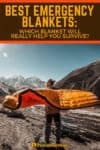
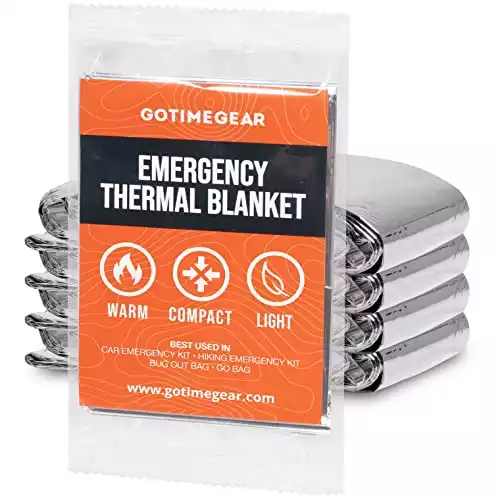
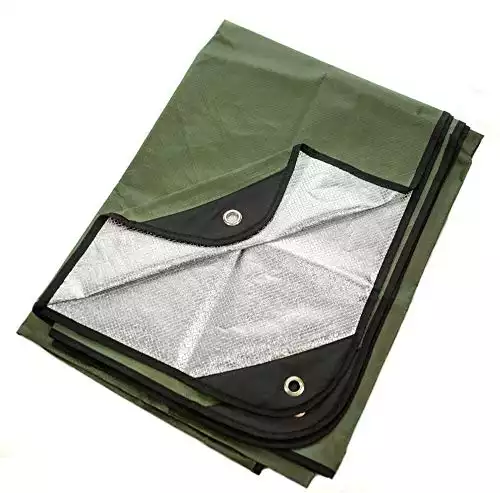
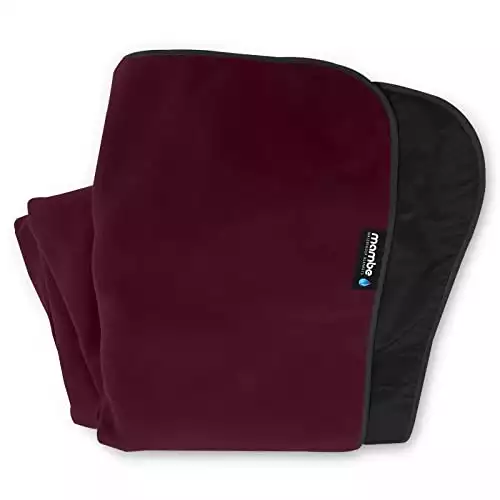
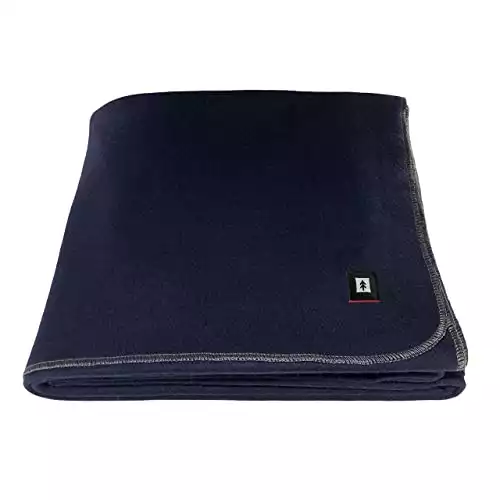
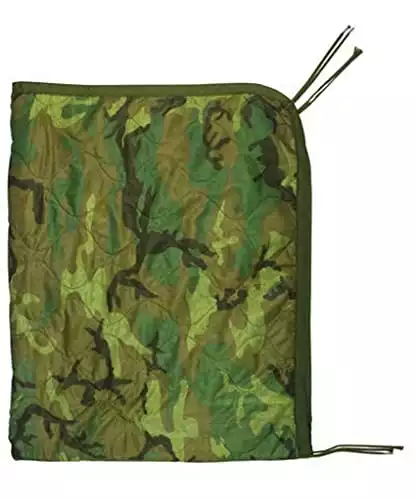
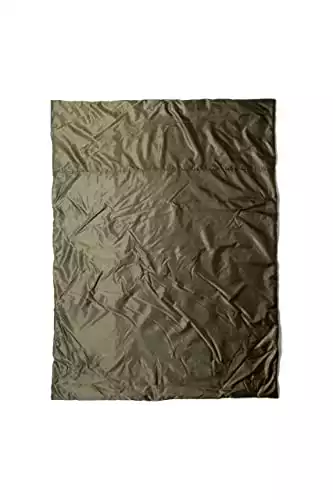
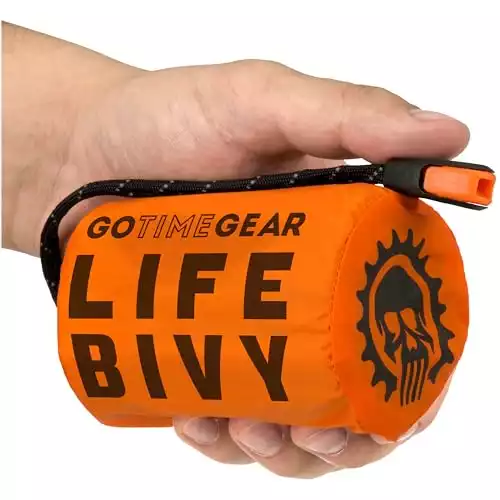
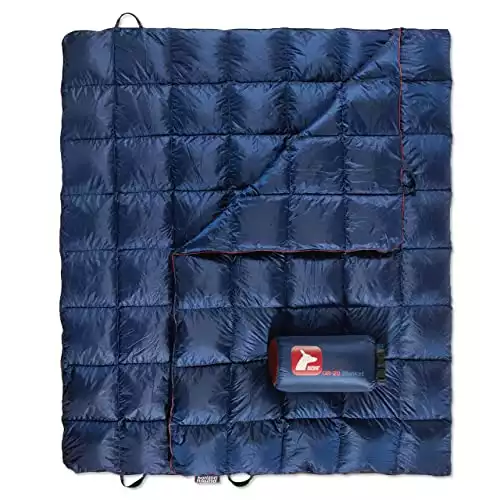








The article seems to indicate down filled bags work when wet. The opposite is true. Down loses its insulative capacity when wet. Most synthetic insulation will perform better than down when wet.
Thank for catching that Andy! I had “wool” in my mind but wrote “down.” The article has been updated accordingly!
One important consideration when thinking about down — you can’t leave a down sleeping bag or down blanket rolled up in your emergency kit. Being stored compressed ruins the loft of the down (the fluffiness) and without loft down provides almost no insulation.
Great point – Thanks for sharing your knowledge.
Very wide-ranging & thorough analysis of the many products in the marketplace. Thankyou for cutting thru the advertising & giving me solid comparisons. Rebuilding my BOB & car bag following separation & moving from a house to an apartment. Also adding to my EDC since my experience of a powerfailure stranding me 7 floors below my apartment for 5 stormy hours (at 71 i cant walk up 14 flights to get home).
Thanks Rod – we try to cover all the angles in these pieces, glad you found it useful.
Hi Rod, if you haven’t done so already, I just wanted to add that you should stockpile A LOT of water. Friends of mine from Sarajevo lived on the 14th floor of a building during the Bosnian War. They went YEARS without power or water. They say that going without power wasn’t such a big deal, but no running water was terrible. Eventually, the people in the building got together to remove the elevator and made a pulley system in the shaft so they could haul water up easier. Better than trying to carry heavy water up that many flights of steps!
Very informative Diane. Ty